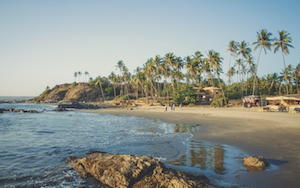There are about 1.3 billion people in India, making it a potentially huge and lucrative marketplace. But as we all know, there is a vast chasm between the poor and the increasingly wealthy. About a quarter of the population has been benefiting from India’s economic growth – that’s 325 million people, not far off the total population of the United States and about 40% the size of the whole of Europe.
Unlike new territories such as China or South America, India has a history of whisky consumption and an understanding of the drink inherited from the days of the Raj.
But whisky as we know it is beyond the reach of the cast majority of Indians and, as Amrut executive director Rick Jagdale put it to me: “People in India are starving and barley is food. It is in that direction it must go first.”
In fact there are four distinct and separate strands to the Indian market: the huge standard blended whisky market aimed at the vast majority of the population; a growing premium blended whisky market often with Scottish malt mixed with Indian grain, aimed at the emerging middle classes; a small but increasingly significant imported whisky market, mainly for Scottish single malt; and Indian single malt whisky made by Amrut and John Distilleries.
Speak to anyone about the Indian internal market and a) you’ll note a tone of very cautious optimism and b) before long you’ll hear the words ‘slowly’ and ‘surely.’ With more emphasis on slowly.
Richard Paterson, master blender for Whyte & Mackay, which was owned by Indian entrepreneur Vijay Mallya before Diageo bought Mallya’s United Spirits, has visited India on numerous occasions.
“Things are changing there but it’s very difficult,” he says. “The import tariffs are very restrictive and each state has its own approach to tax. Some have reduced taxes but it is such a vast place to do business in.”
Krish Kumar, general manager for international sales and marketing at John Distilleries, says there is an increased interest in single malt whisky in India, not just for scotch but for world whiskies and, for the first time, for the likes of his company and Amrut.
“Whiskies in India are on the up at the moment,” he says. “There is a serious increase in the number of tasting clubs and experts in India, who have been enjoying some lovely whiskies. This is where different cultures meet and Indians are loving the tasting sessions where they can enjoy whiskies from different parts of the world.
“We have been conducting several tasting sessions in Goa and have just started engaging in building up the excitement across Bangalore as well. These sessions are eagerly looked forward to and loved by India’s whisky connoisseurs.”
Bangalore is India’s food and drink state, and Goa its most liberal, so perhaps the success of imported spirits is not so surprising. But while the potential of the Indian market is immense, it needs to be put into perspective. In 2013 the top 10 whiskies in India sold about 120m cases, with leading brands Officer’s Choice and McDowell’s almost equally boasting just under 24 million cases each. Single malt whisky in India is all but statistically insignificant in comparison.




